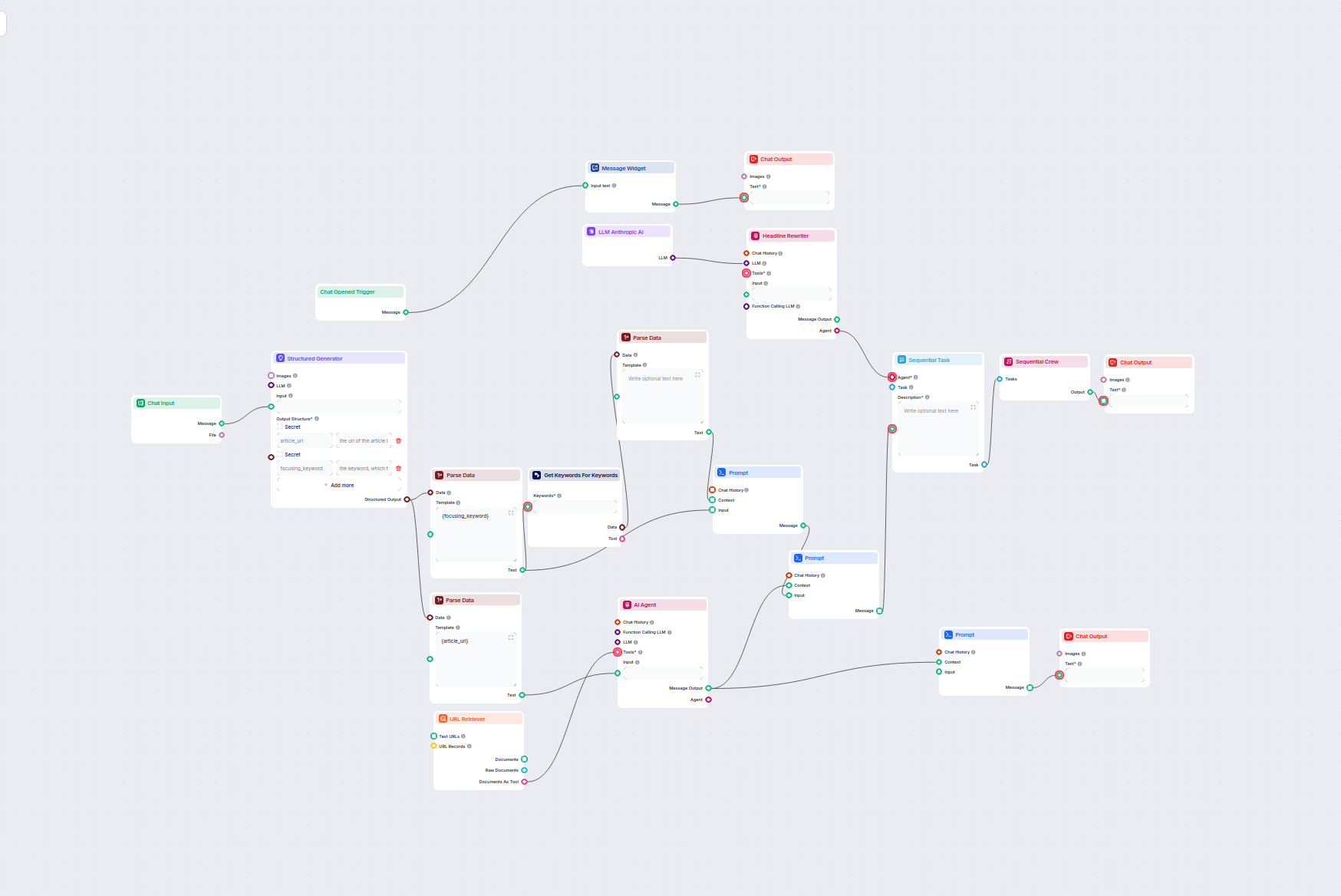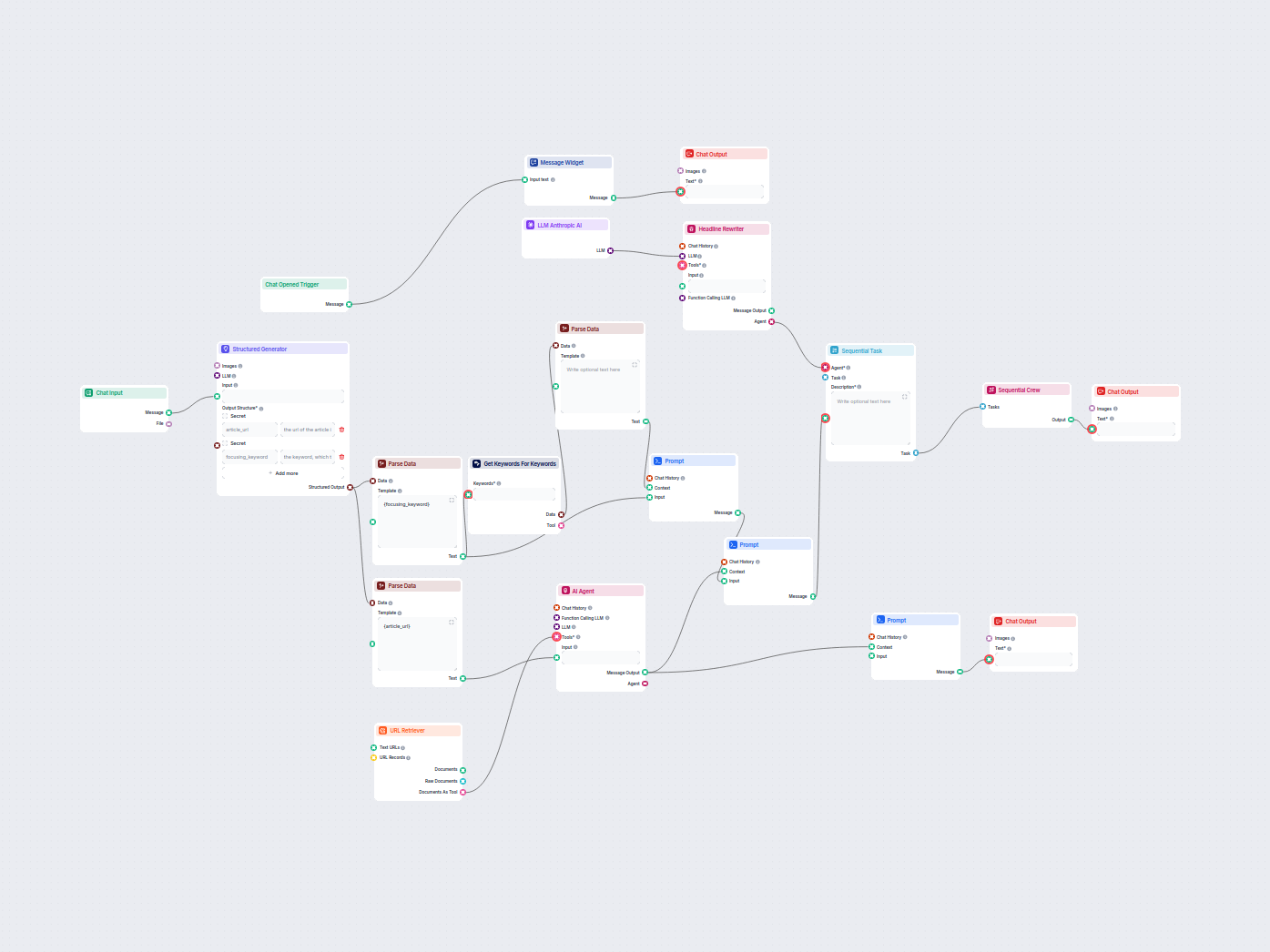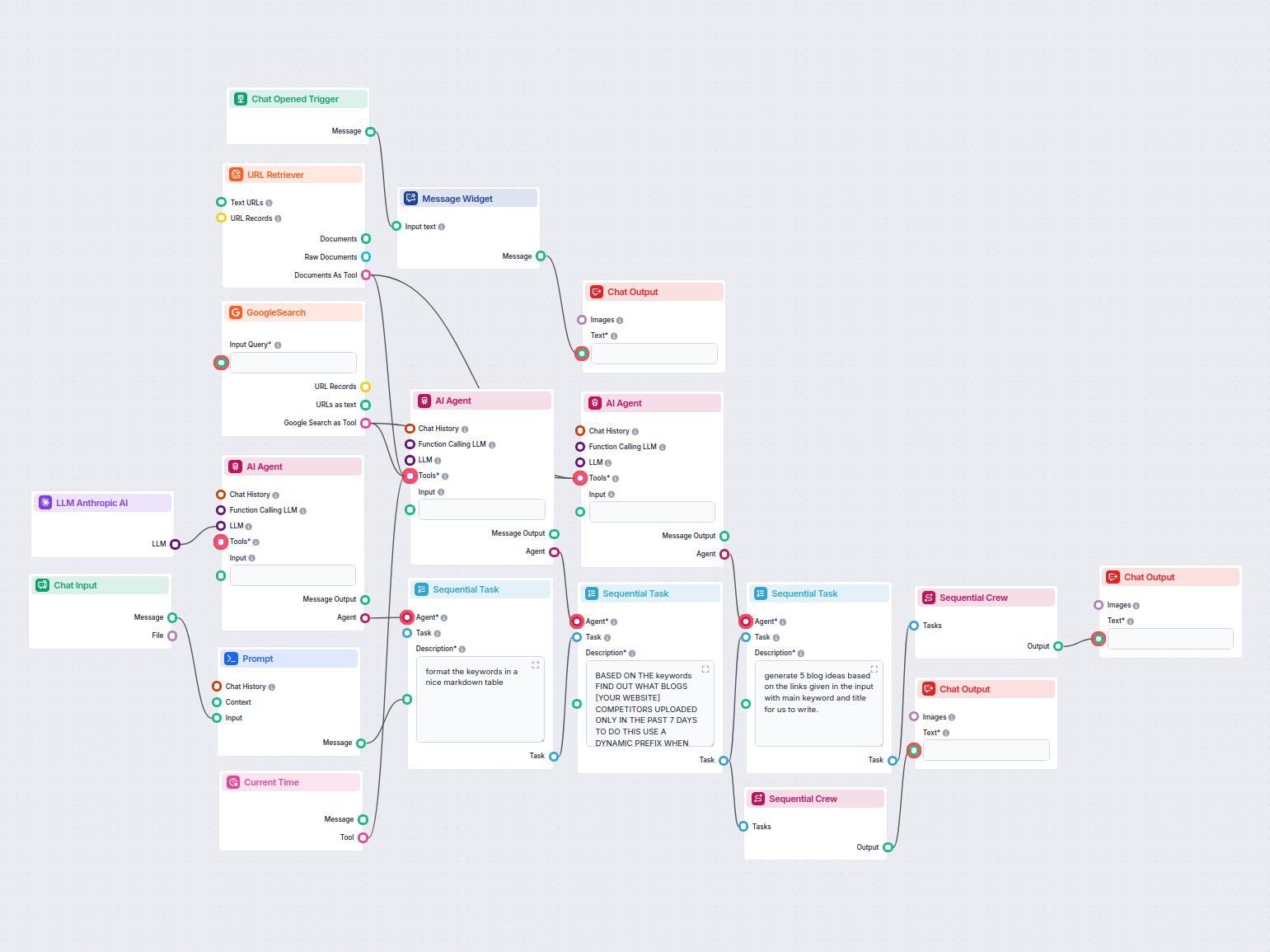Keyword Cluster Prompt
Prompt template for presenting the primary keyword and related keywords in the same cluster.
This AI-powered workflow finds the best SEO keywords for your blog article and automatically rewrites headlines to target those keywords, improving your content’s search engine performance. Ideal for content marketers and SEO specialists looking to boost organic reach and relevance with minimal manual effort.

Flows
Prompt template for presenting the primary keyword and related keywords in the same cluster.
Prompt template instructing the LLM to repurpose article headlines to focus on a new keyword, while keeping paragraphs unchanged.
Prompt template for displaying the extracted article headlines.
Below is a complete list of all components used in this flow to achieve its functionality. Components are the building blocks of every AI Flow. They allow you to create complex interactions and automate tasks by connecting various functionalities. Each component serves a specific purpose, such as handling user input, processing data, or integrating with external services.
The Chat Input component in FlowHunt initiates user interactions by capturing messages from the Playground. It serves as the starting point for flows, enabling the workflow to process both text and file-based inputs.
The Structured Output Generator component lets you create precise, structured data from any input prompt using your chosen LLM model. Define the exact data fields and output format you want, ensuring consistent and reliable responses for advanced AI workflows.
The Parse Data component transforms structured data into plain text using customizable templates. It enables flexible formatting and conversion of data inputs for further use in your workflow, helping to standardize or prepare information for downstream components.
Unlock valuable keyword insights with the Google Keywords Finder component—automate the discovery of related keywords, search volume trends, competition, and cost-per-click data. Perfect for building flows that need real-time keyword research and SEO optimization capabilities.
Learn how FlowHunt's Prompt component lets you define your AI bot’s role and behavior, ensuring relevant, personalized responses. Customize prompts and templates for effective, context-aware chatbot flows.
The AI Agent component in FlowHunt empowers your workflows with autonomous decision-making and tool-using capabilities. It leverages large language models and connects to various tools to solve tasks, follow goals, and provide intelligent responses. Ideal for building advanced automations and interactive AI solutions.
FlowHunt supports dozens of AI models, including Claude models by Anthropic. Learn how to use Claude in your AI tools and chatbots with customizable settings for tailored responses.
The Sequential Task component organizes workflow steps by defining a clear task description, expected output, and assigning an agent to execute the task. Ideal for structured, multi-step processes, it ensures each step is well-documented and assigned, supporting complex automations in FlowHunt.
Experience organized workflow automation with the Sequential Crew component in FlowHunt. This component allows you to group multiple agent tasks and execute them one after another, making it ideal for processes that require clear, step-by-step task processing.
Discover the Chat Output component in FlowHunt—finalize chatbot responses with flexible, multi-part outputs. Essential for seamless flow completion and creating advanced, interactive AI chatbots.
Unlock web content in your workflows with the URL Retriever component. Effortlessly extract and process the text and metadata from any list of URLs—including web articles, documents, and more. Supports advanced options like OCR for images, selective metadata extraction, and customizable caching, making it ideal for building knowledge-rich AI flows and automations.
The Message Widget component displays custom messages within your workflow. Ideal for welcoming users, providing instructions, or showing any important information, it supports Markdown formatting and can be set to appear only once per session.
Flow description
This workflow automates the process of optimizing article headlines to target new, high-potential keywords. It leverages AI and SEO tools to find the best keywords based on user input, extracts headlines from existing articles, and then rewrites those headlines to improve SEO targeting without altering the article content.
Prompt Engineering: The workflow constructs a detailed AI prompt that includes:
Expert Copywriter Agent: An AI agent, acting as a professional copywriter, processes the prompt and generates optimized headlines.
| Step | Purpose | Tool/Agent Used |
|---|---|---|
| User Input | Collect URL and new keyword | Chat Interface |
| Data Structuring | Parse and structure input | Structured Output Generator |
| Keyword Research | Find keyword cluster and metrics | Google Keywords API |
| Headline Extraction | Extract old headlines from article | Headline Extractor AI Agent |
| Prompt Creation | Build AI prompt with keywords & headlines | Prompt Templates |
| Headline Rewriting | Rewrite headlines for SEO targeting | Expert Copywriter AI Agent |
| Output Display | Show optimized headlines to user | Chat Output |
By chaining together AI copywriting, SEO research, and automated extraction, this workflow delivers a robust, repeatable solution for headline optimization that can save hours of manual work and drive better search rankings.
We help companies like yours to develop smart chatbots, MCP Servers, AI tools or other types of AI automation to replace human in repetitive tasks in your organization.
Automatically optimize your article's headlines and title for a specific keyword or keyword cluster to improve SEO performance. This workflow analyzes your arti...
Automatically analyze top-ranking competitor blogs from the past week and generate new blog ideas for your website. This AI workflow researches competitor conte...
This AI-powered workflow analyzes the content structure of your web page, compares it with top-ranking competitor pages, and provides tailored recommendations o...
Cookie Consent
We use cookies to enhance your browsing experience and analyze our traffic. See our privacy policy.



